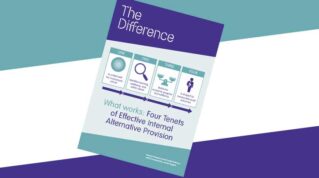The time for government to fulfil its pledge to recruit 6,500 new teachers is “now or never”, a report has warned, as it revealed unfilled teacher vacancies have reached record rates.
The National Foundation for Educational Research (NFER) published its annual “teacher labour market in England” report on Thursday.
It found teacher leaving rates have not improved since before the pandemic and an increasing number of those leaving the profession are of working, rather than retirement age.
This, coupled with consistently low levels of recruitment into initial teacher training, is leading to widespread teacher shortages.
Unfilled vacancies reached six per thousand teachers last academic year – double the pre-pandemic rate and six times higher than when records began in 2010-11.
‘Now or never’ for 6,500 new teachers
The report explains it typically takes “a year or two” for policy actions to impact staffing levels, and “another year or two” for this to show up in reporting data.
Because of this, government faces a critical “now or never” moment if it is deliver on its pledge to address teacher shortages by recruiting 6,500 new teachers during this parliament.
Jack Worth, school workforce lead at NFER and co-author of the report, said recruitment and retention in England “remain in a perilous state, posing a substantial risk to the quality of education”.
“The time for half measures is over,” he said. “Fully funded pay increases that make teacher pay more competitive are essential to keeping teachers in the classroom and attracting new recruits.”
He said the government’s upcoming spending review provides “the ideal opportunity to show its long-term commitment to increase the attractiveness of teaching”.

Pepe Di’Iasio, general secretary of the ASCL leaders’ union, said the government’s target of recruiting 6,500 new teachers “is a step in the right direction” but ministers have laid out “no clear plan for achieving it”.
“The government must take decisive action to address teacher shortages. The upcoming spending review must provide the necessary funding for the Department for Education to develop a meaningful strategy to tackle this crisis.”
More teachers leaving than pre-pandemic
In 2022-23, 9.6 per cent of teachers left teaching. This was slightly lower than the previous year but still higher than before the pandemic, the report found.
Ninety per cent of teachers considering leaving last academic year cited high workload as a factor, while pupil behaviour has become one of the fastest-growing contributors to workload since the pandemic.
The NFER report, funded by the Nuffield Foundation, also found growing teacher shortages are leading to increased reliance on unqualified and non-specialist teachers.
Call for teacher pay boost
Last year’s 5.5 per cent pay rise – together with the previous government’s introduction of £30,000 starting salaries – has returned teacher salaries to 2010-11 levels in real terms, the NFER said.
But teacher pay growth has lagged behind the wider labour force.
The government has proposed a 2.8 per cent for school teachers in 2025-26.
Among a string of recommendations to boost teacher pay, the NFER report urged the School Teachers’ Review Body (STRB) to recommend the teacher pay award for 2025-26 exceeds three per cent.
It also called on government “to ensure that the spending review delivers pay rises in the schools budget” that are necessary to increase teacher pay by at least 6.1 per cent from 2026.
It also urged the government to spend more on financial incentives targeting subjects with a particular teacher shortage, such as maths and physics.
The report also recommended the government develop a “teacher workload reduction strategy” that is “fully integrated with the wider policy reform agenda” to help improve retention.
AI ‘no silver bullet’
The NFER report also recommended schools should consider whether AI tools such as ChatGPT could improve teachers’ workload.
It cited a DfE “working lives of teachers and leaders” study that found those using ChatGPT spent, on average, 30 per cent less time on lesson planning than teachers who did not.
Di’Iasio said reducing “excessive” workloads is key to tackling teacher shortages, but said this requires “systemic change”. He said AI “may help ease some pressure”, but stressed “it is no silver bullet”.
Government ‘committed to resetting relationship with sector’
A Department for Education spokesperson said it was “committed to resetting the relationship with the education workforce and working alongside them to re-establish teaching as an attractive, expert profession”.
They said they were “taking steps” to support teacher wellbeing and easing workload pressures, including encouraging schools to allow staff to work more flexibly, to boost retention.
“Work has already begun, as part of our plan for change, to recruit an additional 6,500 expert teachers, including making £233m available next year to encourage more talented people into the classroom to teach subjects including maths, physics, chemistry and computing.”
















The rubicon was passed when there was all the excitement in the education sector at the senior level when they realised that they could benefit personally financially from the MAT system (sadly) at the expense of the students and staff. Staff well-being has since been pummelled by these over-promoted Ofsted obsessed senior leaders and MAT CEOs and executive heads who have long since left the classroom and have managed through their egregiousness have managed to ruin the most amazing dedicated group of professionals (along with those in the NHS) in a relatively short space of time. The Government have to wind up the MATs, take them back into LEA control (with rigorous financial accountability) and fill the gaps in teaching by sending these supposedly skilled gurus at the top of the MATs back to a full teaching timetable on mainscale or on a very low redundancy (to incentivise them to make the best decision…for the benefit of students, of course).
Pay rises won’t and don’t keep teachers happy and wanting to stay in education.
The sheer workload and expectations to achieve is the biggest reason for why teachers leave and poor behaviour with a lack of support to address it also doesn’t help.
Giving teachers 2.5 hours per week out of class to plan, resource and print for up to 11 subjects is not enough time at all. They therefore makeup that shortfall by working tirelessly on evenings and weekends to get that planning done. The planning has to hit high standards otherwise you get picked apart on observations…….yet another reason why teachers leave. They work tirelessly in their own time mainly to get work done just to be observed continuously to monitor that you’re doing your work in the same way as everyone in the school. God forbid you don’t behave like the robot that they want you to be otherwise that’ll be pulled up too.